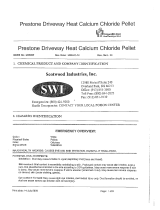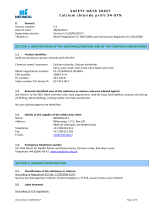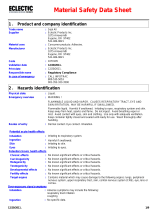Page is loading ...

© 2016 by Snow Joe
®
, LLC
All rights reserved. Original instructions.
Produced by Kissner, Inc.
expressly for Snow Joe
®
, LLC
SAFETY DATA SHEET
(S.D.S)
SAVE THESE S.D.S.
Form No. SJ-MELT-S.D.S
*when used as directed
FAST ACTING • INSTANT TRACTION • SAFER ON SIDEWALKS*
BEET-IT ICE MELTER
Enriched with CMA + Beet Extract
1
Section 1: Product Identication
Product Name MELT Beet -It
Identied Uses Melt snow and ice
Supplier's Details Snow Joe
®
, LLC
305 Veterans Blvd
Carlstadt, NJ USA 07072
Phone Number 1-866-SNOWJOE (1-866-766-9563)
Emergency Contact (24 Hrs) (613) 996-6666 CANUTEC
Section 2: Hazard Identication
Classication (GHS) Not classied.
GHS Labelling No labelling applicable.
Percentage Not applicable.
Other Hazards Exposure may aggravate those with pre-existing eye, skin, or respiratory
conditions. When heated to decomposition, emits toxic fumes. Corrosive to
metals upon prolonged contact.
Section 3: Composition/Information On Ingredients
Ingredients Percentage CAS. NO. Classication
Sodium Chloride 85.0-99.9% 7647-14-5 Not Classied
Calcium Chloride 0.01-5.0% 10043-52-4 Eye Irrit. 2A, H319
Magnesium Chloride 0.01-5.0% 7786-30-3 Not Classied
Potassium Chloride 0.01-5.0% 7447-40-7 Aquatic Acute 3, H402
Beet Extract Solution
(Beet Ranate)
Not Applicable
Product may contain
color indicator
Not Applicable

2
Section 4: First-Aid Measures
Description of First Aid Measures
General Never give anything by mouth to an unconscious person.
If you feel unwell, seek medical advice.
Inhalation When symptoms occur: go into open air and ventilate suspected area.
Remove to fresh air and keep at rest in a position comfortable for breathing.
Obtain medical attention if breathing diculty persists.
Skin Contact Remove contaminated clothing. Brush o loose particles. Drench aected
area with water for at least 15 minutes. Obtain medical attention if irritation
persists. Wash contaminated clothing before reuse.
Eye Contact Rinse cautiously with water for several minutes. Brush o loose particles.
Remove contact lenses, if present and easy to do. Continue rinsing. Obtain
medical attention if irritation develops or persists.
Ingestion Rinse mouth. Do NOT induce vomiting.
Immediately call a POISON CENTER or doctor/physician.
Most Important Symptoms and Eects Both Acute and Delayed
General Dust may cause mechanical irritation to eyes, nose, throat and lungs.
Inhalation Prolonged contact with large amounts of dust may cause mechanical.
irritation.
Skin Contact Skin contact with large amounts of dust may cause mechanical irritation.
Eye Contact Contact may cause irritation due to mechanical abrasion.
Ingestion Ingestion is not likely to be harmful or have adverse eects.
Other Contact with large amount of dust may cause mechanical irritation to eyes,
nose, throat, and lungs.
Chronic Symptoms Not available.
Section 5: Fire-Fighting Measures
Suitable Extinguishing Media Use extinguishing media appropriate for surrounding re.
Unsuitable Extinguishing Media Do not use a heavy water stream. Use of heavy stream of water may
spread re.
Fire Hazard Not considered ammable but may burn at high temperatures.
Explosion Hazard Product is not explosive.
Reactivity When heated to decomposition, emits toxic fumes. Toxic Gas.
Hazardous Combustion Products Toxic fumes are released. Hydrogen chloride. Sodium oxides. Chlorine.
Other Information Do not allow run-o from reghting to enter drains or water courses.
Section 6: Accidental Release Measures
Personal Precautions Avoid breathing (dust). Avoid all contact with skin, eyes, or clothing.
Protective Equipment Use appropriate personal protection equipment (PPE).
Environmental Precautions Prevent entry to sewers and public waters. Avoid release to the
environment.
Methods for Cleaning Up Clear up spills immediately and dispose of waste safely. Recover the
product by vacuuming, shoveling or sweeping. Contact competent
authorities after a spill.

3
Section 7: Handling and Storage
Precautions for Safe Handling
Additional Hazards When Processed When heated to decomposition, emits toxic fumes. Contact with water
causes an exothermic heat reaction, which may cause signicant
temperature rise. Corrosive to metal upon prolonged contact. May release
hydrogen gas on prolonged contact with certain metals.
Hygiene Measures Handle in accordance with good industrial hygiene and safety procedures.
Wash hands and other exposed areas with mild soap and water before
eating drinking, or smoking and again when leaving work. Do not eat, drink
or smoke when using this product. Wash hands and forearms thoroughly
after handling.
Conditions for Safe Storage, Including Any Incompatibilities Technical Measures
Comply with applicable regulations. Store in a dry, cool and well-ventilated
place. Keep container closed when not in use.
Storage Conditions Keep/store away from extremely high or low temperatures, direct sunlight,
heat, ignition sources, and incompatible materials.
Incompatible Materials Strong acids. Strong bases. Strong oxidizers.
Section 8: Exposure Controls/Personal Protection
Control Parameters No Occupational Exposure Limits (OELs) have been established for this
product or its chemical components.
Appropriate Engineering Controls Emergency eye wash fountains and safety showers should be available in
the immediate vicinity of any potential exposure. Ensure all national/local
regulations are observed. Ensure adequate ventilation, especially in
conned areas.
Personal Protective Equipment Protective goggles. Protective clothing. Insucient ventilation: wear
respiratory protection. Gloves.
Materials for Protective Clothing Chemically resistant materials and fabrics.
Hand Protection Wear chemically resistant protective gloves.
Eye Protection Chemical goggles or face shield.
Skin and Body Protection Wear suitable protective clothing.
Respiratory Protection Use NIOSH-approved air-purifying or supplied-air respirator where airborne
concentrations are expected to exceed exposure limits.
Section 9: Physical And Chemical Properties
Appearance/Physical State Purple Colored Granules.
Vapour Pressure (mm Hg at 20ºC) Not available.
Vapour Density (Air = 1.0) Not available.
Bulk Density Not available.
Solubility in Water Water Soluble.
Specic Gravity (gm/cc, Water = 1.0) Not available.
% Volatile by Volume Not-volatile.
Boiling Range (Deg. Celsius) Not available.
Melting Point Not available.
pH 10 (1% solution @ 20ºC).

4
Section 10: Stability And Reactivity
Chemical Stability Stable under normal conditions.
Reactivity When heated to decomposition, emits toxic fumes. Toxic Gas.
Possibility of Hazardous Reactions Polymerization occurs when calcium chloride when mixed with methyl
vinyl ether.
Conditions to Avoid Direct sunlight. Extremely high or low temperatures. Incompatible materials.
Incompatible Materials Strong acids. Strong bases. Strong oxidizers. Reactive metals.
Hazardous Decomposition Products Toxic gases. Hydrogen chloride. Chlorine. Sodium oxides. Oxides of
magnesium. Oxides of calcium.
Section 11: Toxicological Information
Acute Toxicity Not classied.
LD50 and LC50 Data Not available.
Skin Corrosion/Irritation Not classied.
Serious Eye Damage/Irritation Not classied.
Respiratory or Skin Sensitization Not classied.
Germ Cell Mutagenicity Not classied.
Teratogenicity Not available.
Carcinogenicity Not classied.
Specic Target Organ Toxicity (Repeated Exposure) Not classied.
Reproductive Toxicity Not classied.
Specic Target Organ Toxicity (Single Exposure) Not classied.
Aspiration Hazard Not classied.
Information on Toxicological Eects - Ingredient(s)
Sodium Chloride (7647-14-5)
LD50 Oral Rat 3 g/kg
LC50 Inhalation Rat > 42 g/m3 (Exposure time: 1 h)
Calcium Chloride (10043-52-4)
LD50 Oral Rat 1455-2781 mg/kg
LD50 Dermal Rabbit > 5000 mg/kg
Potassium Chloride (7447-40-7) LD50 Oral Rat 2600 mg/kg
Section 12: Ecological Information
Toxicity No additional information available.
Sodium Chloride (7647-14-5)
LC50 Fish 1
5560 (5560 - 6080) mg/l (Exposure time: 96 h - Species: Lepomis macrochirus
[ow-through])
EC50 Daphnia 1
1000 mg/l (Exposure time: 48 h - Species: Daphnia magna)
LC 50 Fish 2 12946 mg/l (Exposure time: 96 h - Species: Lepomis macrochirus [static])
EC50 Daphnia 2 340.7 (340.7 - 469.2) mg/l (Exposure time: 48 h - Species: Daphnia magna [static])
Calcium Chloride (10043-52-4)
LC50 Fish 1 10650 mg/l (Exposure time: 96 h - Species: Lepomis Macrochirus [static])
EC50 Daphnia 1
2400 mg/l (Exposure time: 48 h - Species: Daphnia magna)

5
Potassium Chloride (7447-40-7)
LC50 Fish 1 1060 mg/l (Exposure time: 96 h - Species: Lepomis macrochirus [static])
EC50 Daphnia 1
825 mg/l (Exposure time: 48 h - Species: Daphnia magna)
LC 50 Fish 2
750-1020 mg/l (Exposure time: 96 h - Species Pimephales Promelas [stactic])
EC50 Daphnia 2
83 mg/l (Exposure time: 48 h - Species: Daphnia magna [stactic])
Persistence and degradability Not available.
Bio accumulative potential
Sodium chloride (7647-14-5) BCF Fish 1 (no bioaccumulation)
Calcium chloride (10043-52-4)
BCF Fish 1 (no bioaccumulation)
Mobility in Soil Not available.
Other Information Avoid release to the environment.
Section 13: Disposal Considerations
Waste Disposal Recommensations Dispose of waste material in accordance with all local, regional, national,
provincial, territorial and international regulations.
Section 14: Transport Information
In Accordance with DOT Not regulated for transport.
In Accordance with IMDG Not regulated for transport.
In Accordance with IATA Not regulated for transport.
In Accordance with TDG Not regulated for transport.
Section 15: Regulatory Information
US Federal Regulations
Sodium Chloride (7647-14-5) Listed on the United States TSCA (Toxic Substances Control Act) inventory
Calcium Chloride (10043-52-4)
Listed on the United States TSCA (Toxic Substances Control Act) inventory
Potassium Chloride (7447-40-7) Listed on the United States TSCA (Toxic Substances Control Act) inventory
US Federal Regulations
MELT Beet-It
WHMIS Classication
Uncontrolled product according to WHMIS classication criteria
Sodium Chloride (7647-14-5) Listed on the Canadian DSL (Domestic Substances List)
WHMIS Classication
Class D Division 2 Subdivision B - Toxic material causing other toxic eects
Sodium Chloride (7647-14-5) Listed on the Canadian DSL (Domestic Substances List)
WHMIS Classication
Class D Division 2 Subdivision B - Toxic material causing other toxic eects
Magnesium Chloride (7786-30-3)
WHMIS Classication
Uncontrolled product according to WHMIS classication criteria
Potassium Chloride (7447-40-7) Listed on the Canadian DSL (Domestic Substances List)
WHMIS Classication
Class D Division 2 Subdivision B - Toxic material causing other toxic eects
This product has been classied in accordance with the hazard criteria of the Controlled Products Regulations (CPR) and
the SDS contains all of the information required by CPR.

6
Snow Joe
®
, LLC Carlstadt, NJ, USA
1-866-SNOWJOE (1-866-766-9563)
snowjoe.com
R
R
Section 16: Other Information
Other Information This document has been prepared in accordance with the SDS
requirements of the OSHA Hazard Communication Standard 29 CFR
1910.1200.
Eective Date October 26, 2016
Version 1
Contact snowjoe.com
The information is, to the best of knowledge and belief, accurate and reliable as of the date compiled. However, no
representation, warranty or guarantee is made to its accuracy, reliability or completeness. It is the user’s responsibility to
review this information, satisfy themselves as to its suitability and completeness and pass on the information to its employees
or customers. Snow Joe
®
, LLC does not accept responsibility for any loss or damage, which may occur from the use of this
information.
/






